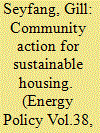|
|
|
Sort Order |
|
|
|
Items / Page
|
|
|
|
|
|
|
| Srl | Item |
| 1 |
ID:
101455


|
|
|
|
|
| Publication |
2010.
|
| Summary/Abstract |
This paper presents a new analytical framework of 'grassroots innovations' which views community-led initiatives for sustainable development as strategic green niches with the potential for wider transformation of mainstream society. This framework is applied to a low-carbon, low-impact, community-based sustainable housing initiative in the USA that pioneers straw bale housing techniques within a strong community-building ethos. The project is evaluated according to New Economics criteria of sustainable consumption, and is found to be successful at localising the construction supply chain, reducing ecological footprints, community-building, enabling collective action and building new institutions and systems of provision around housebuilding. However, viewing it as a strategic niche with aim to influence wider society, it is clear that it faces significant challenges in diffusing its ideas and practices beyond the niche. Its model is not necessarily suitable for scaling up or widespread replication; however, the scope for niche lessons to be adopted by mainstream builders is greater, given a supportive policy environment. Recognising the innovative nature of green niches at the policy level could lead to new approaches to governance of bottom-up community action for sustainable development.
|
|
|
|
|
|
|
|
|
|
|
|
|
|
|
|
| 2 |
ID:
101451


|
|
|
|
|
| Publication |
2010.
|
| Summary/Abstract |
Over the last decade the important role that local authorities can play in catalyzing community action on climate change has been repeatedly emphasised by the UK Government. The paper examines this policy context and explores the options available to local authorities in terms of reaching and engaging their communities. The type of progressive response shown by some UK local authorities is illustrated with empirical evidence gathered through a study conducted in the London Borough of Islington focusing on their recently established 'Green Living Centre'. The results confirm interest in this major council-led community initiative, with positive attitudes expressed by the majority of those questioned in terms of the advice and information available. However, it is also clear that many participants had preexisting pro-environmental attitudes and behavioural routines. Results from a broader sample of Islington residents indicate a substantial challenge in reaching the wider community, where enthusiasm for sustainability change and interest in this type of scheme were more mixed. The prospect for local government in addressing this challenge - and their ability to trigger and capitalize upon concepts of social change at the community level towards a lower carbon future - is discussed in the final part of the paper.
|
|
|
|
|
|
|
|
|
|
|
|
|
|
|
|
| 3 |
ID:
112290


|
|
|
|
|
| Publication |
2012.
|
| Summary/Abstract |
California's target for reducing economy-wide greenhouse gas (GHG) emissions is 80% below 1990 levels by 2050. We develop transition scenarios for meeting this goal in California's transportation sector, with focus on light-duty vehicles (LDVs). We explore four questions: (1) what options are available to reduce transportation sector GHG emissions 80% below 1990 levels by 2050; (2) how rapidly would transitions in LDV markets, fuels, and travel behaviors need to occur over the next 40 years; (3) how do intermediate policy goals relate to different transition pathways; (4) how would rates of technological change and market adoption between 2010 and 2050 impact cumulative GHG emissions?
We develop four LDV transition scenarios to meet the 80in50 target through a combination of travel demand reduction, fuel economy improvements, and low-carbon fuel supply, subject to restrictions on trajectories of technological change, potential market adoption of new vehicles and fuels, and resource availability.
These scenarios exhibit several common themes: electrification of LDVs, rapid improvements in vehicle efficiency, and future fuels with less than half the carbon intensity of current gasoline and diesel. Availability of low-carbon biofuels and the level of travel demand reduction are "swing factors" that influence the degree of LDV electrification required.
|
|
|
|
|
|
|
|
|
|
|
|
|
|
|
|
|
|
|
|
|